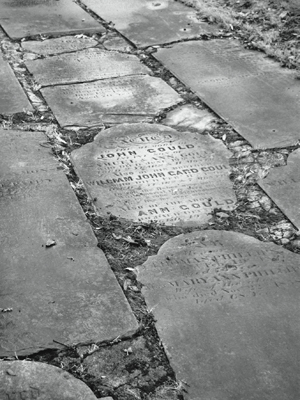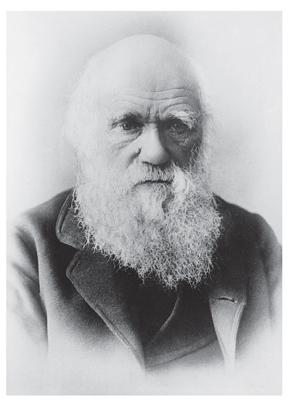Plymouth (17 page)
Authors: Laura Quigley

Ellis realised something was wrong and, with remarkable intuition, decided to return to the graveyard that evening with his constables, James Day, Roger Halse, Ambrose Nosworthy and a fourth called Pike. Pike and Ellis hid in a north-east corner. After two hours of sitting in the dark, they heard someone digging in the graveyard, apparently from the spot where a body had been buried that day. Ellis saw a man wandering about, one who gave the appearance of being a look-out, but he could make out nothing more in the dark. Just before dawn, Ellis took his men to No. 4, where Ellis and Nosworthy climbed over into the back garden. Finding the back door locked, Ellis tried the window. Suddenly John Jones appeared, partly dressed. Ellis gave a plausible explanation – he said he was looking for deserters – while Nosworthy forced his way through the open window and past the servant. He then unlocked the back door, and the policemen entered the house.
The scene inside was sickening. Ellis found two sacks lying on the floor in the middle of the kitchen, a hole revealing at least one human body inside. In a kitchen cupboard they discovered a bag of human teeth; in the parlour, piles of grave-clothes. Here was the first – and last – mistake made by Thomas Goslin, and the great mystery of his capture. To steal the grave-clothes was theft, punishable by hanging or transportation. For the first time in all his years as a ‘resurrectionist’, he was caught stealing. Ellis and his men found the other body-snatchers still in bed – though Robert Thompson was in fact hiding
under
the bed and refused to come out; he was eventually dragged out by the police. As a final horror, the police made another macabre discovery: the nearby sink was full of teeth.
With the culprits locked up, Ellis searched the graveyard to confirm that the bodies interred just the previous day were in fact missing, and very likely were the two corpses now resting on the Goslins’ kitchen floor. News of the grave-robbing reached the community, and suddenly there were hundreds of people in Stoke Damerel churchyard, all demanding to check that their deceased loved ones were still buried in the churchyard.
In all, nine bodies were found to be missing. Seven were never recovered. Many others had been disturbed, but left when found to be too decomposed. This didn’t stop the ‘resurrectionists’ removing the heads, however, and the piles of teeth at the Goslins’ house were proof that they were making a substantial income from this grisly haul alone.
The two bodies on the Goslins’ kitchen floor were quietly restored to their graves. The first was that of an eighteen-year-old girl called Eliza Hanger from Devonport. The other was that of Thomas Webb, fifty-four, from Garden Street, whose corpse was still oozing from the sickness that killed him.
The Goslins and their staff had to be escorted under armed guard to Exeter, and entered the courtroom protected by double rows of constables – anything less would have seen them lynched. There the Goslins seemed unrepentant. An onlooker pointed at Louisa Goslin and asked, ‘has that woman been stealing bodies?’ Louisa confirmed that she had – and declared that she would do so again, given the chance. In the nineteenth century a wife was rarely condemned for her husband’s crimes – certainly this saved Mary Thompson from punishment – but on this occasion Louisa Goslin damned herself. Along with her husband and his two male associates, Louisa was found guilty of theft and sentenced to transportation for seven years to the settlement at Van Dieman’s Land, now known as Tasmania, off the southern coast of Australia.
![]()
Stoke Damerel churchyard is a quietly attractive though rather grim place now, the churchyard empty of bodies. In 1870, the graveyard was so overcrowded with coffins that some had actually broken the surface, and locals were complaining of the smell. The bodies were disinterred and moved to Efford Cemetery. The remaining gravestones were then laid flat into gruesome paving stones, forming an eerie path. The cracked and sometimes broken paving stones lifting away from the soil leave the visitor with the disturbing impression that the grave-robbers may never have departed.
![]()

Gravestones in Stoke Damerel churchyard.
It may be that Thomas himself did not steal the clothes: he had always been very particular about leaving the grave-clothes in the coffin. However, evidence produced in court revealed that the pile of grave-clothes found in the kitchen may not have been the only clothing stolen during the Goslins’ career: one of the constables found a lady’s shift on a chair in the back parlour, wet as though recently washed. Louisa tried to claim that it was hers, but Elizabeth Netting confirmed in court that her mother-in-law had been buried in that very item.
Thomas Goslin, John Jones and Richard Thompson were first sent to the prison hulk,
Captivity
, sitting in the Hamoaze, the estuary near Devonport. Unlike other prisoners, they were never taken off the ship to work on land in the gangs. The authorities knew full well that their lives would be in danger if the public spotted them. Louisa spent fourteen days of hard labour at Exeter Bridewell, eventually joining her husband and his friends on their way to the brutal convict colony in Van Dieman’s Land. They served their sentences, took their punishments and lived on in the New World, never to return.
1831
HUMAN TRAFFIC
I
N 1831, WHILE
his ship was being refitted in Devonport dockyard, Robert Fitzroy advertised that he was looking for a scientist to travel with him on his second surveying voyage to the Cape Verde islands and the coasts of South America.
Charles Robert Darwin, failed medical student and budding naturalist, applied – but was at first refused. Fitzroy was a committed Tory, who accepted slavery as a necessary evil, while Darwin was a Whig from a family of very active anti-slavery reformers. The two men would never get along.
![]()
In May 1674, a slave called Joseph Bando ran away from his master’s house on Mark Lane in Plymouth.
Joseph must have been an unusual sight. Slaves were an expensive luxury in Plymouth as most of the population could not afford £24 for a slave, though slaves did work farms in Tamerton Foliot for a while. So the sight of an escaped slave in Plymouth must have turned people’s heads. Bando was tall, slender, about seventeen, a little disfigured by smallpox, wearing a blue livery coat and breeches, edged with white, with blue stockings and a gold wire in his right ear. A reward was advertised in the
London Gazette
, but whether the poor man was re-captured is not known.
![]()
As a phrenologist, a popular science of its day, Fitzroy believed that the appearance and structures of a man’s face and skull determined his capabilities and his character. To Fitzroy, the inferiority of the African slave was a scientific matter. Fitzroy was unimpressed by the shape of Darwin’s nose as well as his politics, but a mutual friend brought them together and Darwin was finally accepted on board Fitzroy’s ship, the famous HMS
Beagle
, for a voyage that would change the world with Darwin’s controversial theories of evolution, the origins of man and survival of the fittest. It was also a voyage into the slave trade.

Charles Darwin, who sailed from Plymouth. (LC-DIG-ggbain-03485)
Throughout the 1700s, Plymouth ships continued Hawkins’ notorious enterprise. The
Pindar
set out from Plymouth in 1707, and disembarked 285 slaves at Jamaica. In 1709 the
Joseph
deposited a further 280 slaves there. The civil leaders and merchants in Plymouth were active participants, calling for a repeal of taxes on any slave trading, and petitioning the House of Commons in 1710 for a free and open slave trade. The tax was eventually repealed, though mainly to the benefit of the ports at Bristol and Liverpool. In 1713 Britain became the leading slave-trading country, guaranteeing the delivery of 144,000 slaves to the Spanish Caribbean over the next thirty years.
As details of the horrific treatment of slaves reached the general public, however, the acceptance of slavery abruptly changed, both in Plymouth and across the country. In 1807 the abolitionists, Darwin’s family included, finally succeeded in making it unlawful for any British citizen to capture or transport slaves, but the ownership of slaves was still commonplace throughout the British colonies, providing labour for the production of all those wonderful commodities – sugar, tea, coffee and cotton. The trafficking of human beings was banned, but not the ownership – which meant that slave ships still supplied the plantations, though now they came under attack from the British Navy. Between 1814 and 1828, public meetings were held in Plymouth desperately calling for a final end to all forms of slavery in Britain and all her colonies.